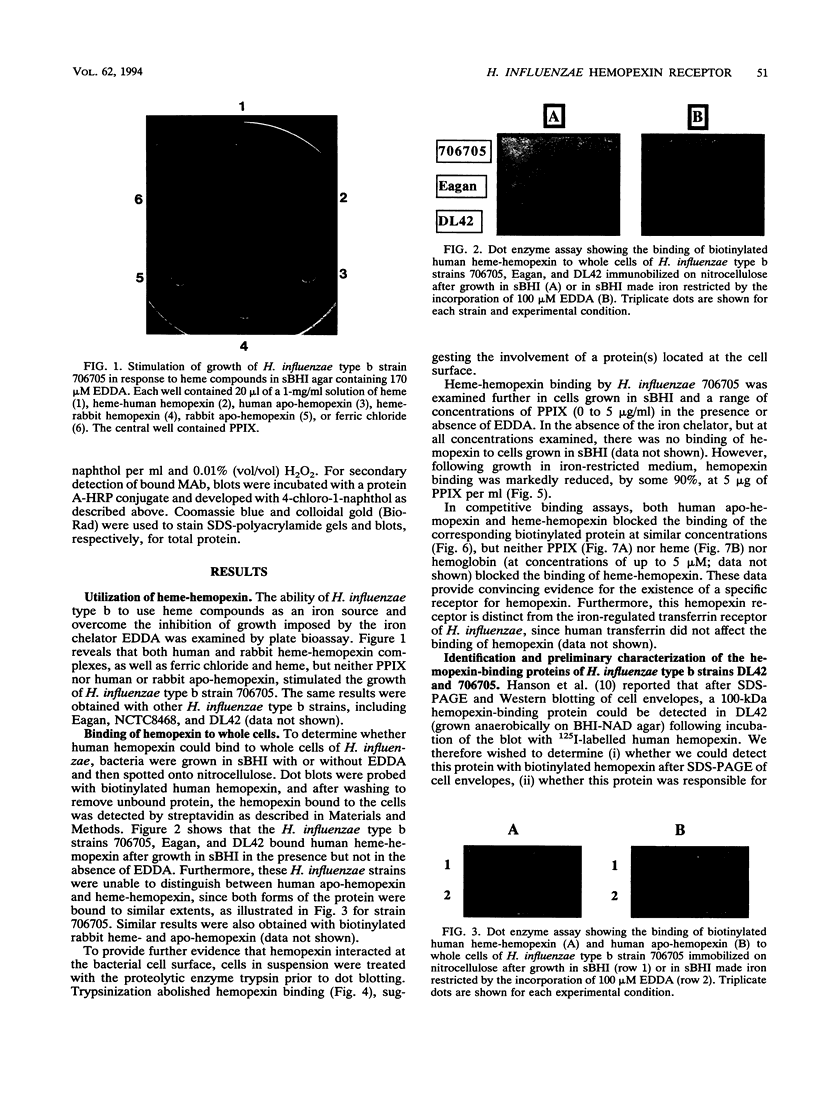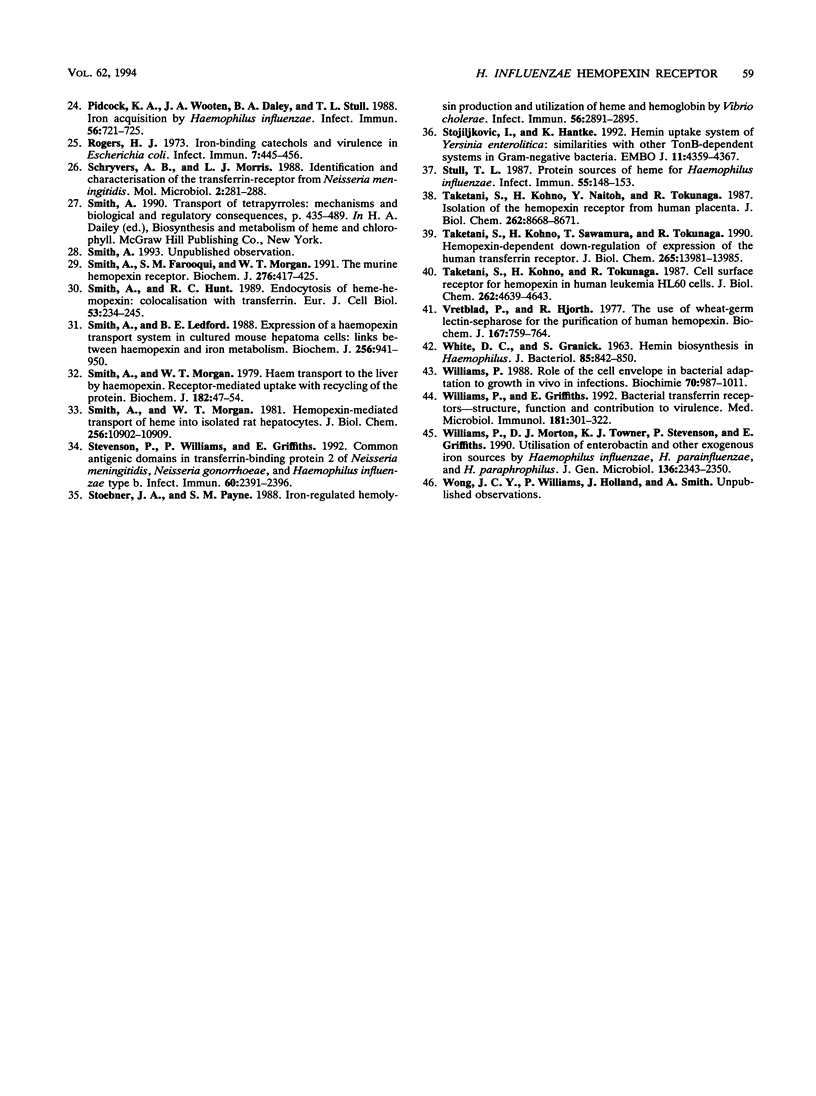Abstract
Heme can serve Haemophilus influenzae as a source of both essential porphyrin and iron. In extracellular mammalian body fluids neither free heme nor free iron is available, since they are tightly bound to hemopexin and transferrin, respectively. Since H. influenzae grows in the presence of iron-transferrin and heme-hemopexin and is known to express a saturable receptor for transferrin, we investigated the process by which this pathogen acquired heme from hemopexin for use as an iron source. The ability of human and rabbit hemopexin to donate heme as a source of iron to H. influenzae type b strains was demonstrated by plate bioassays. With a dot enzyme assay with biotinylated hemopexin as ligand, H. influenzae bound heme-hemopexin and apo-hemopexin following growth in iron-restricted, but not in iron-sufficient, medium. Competitive binding studies with heme-hemopexin and apo-hemopexin demonstrated saturability of binding. Neither heme, protoporphyrin IX, hemoglobin, nor transferrin blocked the binding of hemopexin to whole cells, demonstrating the specificity of binding. Treatment of whole H. influenzae cells with trypsin abolished binding. Taken together, these observations suggest that H. influenzae type b expresses an outer membrane protein(s) which acts as a receptor for hemopexin and which is regulated by the availability of iron in the growth medium. In iron-restricted media, H. influenzae 706705 and DL42 did not express the 100-kDa hemopexin-binding protein previously reported (M.S. Hanson, S.E. Pelzel, J. Latimer, U. Muller-Eberhard, and E.J. Hansen, Proc. Natl. Acad. Sci. USA 89:1973-1977, 1992). The putative iron-regulated hemopexin receptor was solubilized from cell envelopes of H. influenzae 706705, DL42, and Eagan with the detergent CHAPS (3-[(3-cholamidopropyl)-dimethyl-ammonio]-1-propanesulfonate) and isolated by affinity chromatography on heme-hemopexin-Sepharose 4B. Sodium dodecyl sulfate-polyacrylamide gel electrophoresis of the proteins bound to the affinity resin revealed three proteins of 29, 38, and 57 kDa, of which the 57- and 29-kDa proteins bound hemopexin after Western blotting (immunoblotting). A monoclonal antibody to the 57-kDa hemopexin-binding protein of 706705 recognized a 57-kDa protein on Western blots of the cell envelope proteins of 706705, DL42, and Eagan; no reaction was observed with the 100-kDa hemopexin-binding protein of DL42. These data suggest that some H. influenzae strains possess at least two hemopexin receptors, the expression of which is determined by the prevailing growth environment.
Full text
PDF











Images in this article
Selected References
These references are in PubMed. This may not be the complete list of references from this article.
- Brown M. R., Williams P. The influence of environment on envelope properties affecting survival of bacteria in infections. Annu Rev Microbiol. 1985;39:527–556. doi: 10.1146/annurev.mi.39.100185.002523. [DOI] [PubMed] [Google Scholar]
- Crosa J. H. Genetics and molecular biology of siderophore-mediated iron transport in bacteria. Microbiol Rev. 1989 Dec;53(4):517–530. doi: 10.1128/mr.53.4.517-530.1989. [DOI] [PMC free article] [PubMed] [Google Scholar]
- Daskaleros P. A., Stoebner J. A., Payne S. M. Iron uptake in Plesiomonas shigelloides: cloning of the genes for the heme-iron uptake system. Infect Immun. 1991 Aug;59(8):2706–2711. doi: 10.1128/iai.59.8.2706-2711.1991. [DOI] [PMC free article] [PubMed] [Google Scholar]
- Dyer D. W., West E. P., Sparling P. F. Effects of serum carrier proteins on the growth of pathogenic neisseriae with heme-bound iron. Infect Immun. 1987 Sep;55(9):2171–2175. doi: 10.1128/iai.55.9.2171-2175.1987. [DOI] [PMC free article] [PubMed] [Google Scholar]
- Griffiths E. Iron and bacterial virulence--a brief overview. Biol Met. 1991;4(1):7–13. doi: 10.1007/BF01135551. [DOI] [PubMed] [Google Scholar]
- Hanson M. S., Hansen E. J. Molecular cloning, partial purification, and characterization of a haemin-binding lipoprotein from Haemophilus influenzae type b. Mol Microbiol. 1991 Feb;5(2):267–278. doi: 10.1111/j.1365-2958.1991.tb02107.x. [DOI] [PubMed] [Google Scholar]
- Hanson M. S., Pelzel S. E., Latimer J., Muller-Eberhard U., Hansen E. J. Identification of a genetic locus of Haemophilus influenzae type b necessary for the binding and utilization of heme bound to human hemopexin. Proc Natl Acad Sci U S A. 1992 Mar 1;89(5):1973–1977. doi: 10.1073/pnas.89.5.1973. [DOI] [PMC free article] [PubMed] [Google Scholar]
- Hanson M. S., Slaughter C., Hansen E. J. The hbpA gene of Haemophilus influenzae type b encodes a heme-binding lipoprotein conserved among heme-dependent Haemophilus species. Infect Immun. 1992 Jun;60(6):2257–2266. doi: 10.1128/iai.60.6.2257-2266.1992. [DOI] [PMC free article] [PubMed] [Google Scholar]
- Harkness R. E., Chong P., Klein M. H. Identification of two iron-repressed periplasmic proteins in Haemophilus influenzae. J Bacteriol. 1992 Apr;174(8):2425–2430. doi: 10.1128/jb.174.8.2425-2430.1992. [DOI] [PMC free article] [PubMed] [Google Scholar]
- Holland J., Langford P. R., Towner K. J., Williams P. Evidence for in vivo expression of transferrin-binding proteins in Haemophilus influenzae type b. Infect Immun. 1992 Jul;60(7):2986–2991. doi: 10.1128/iai.60.7.2986-2991.1992. [DOI] [PMC free article] [PubMed] [Google Scholar]
- Kino K., Tsunoo H., Higa Y., Takami M., Hamaguchi H., Nakajima H. Hemoglobin-haptoglobin receptor in rat liver plasma membrane. J Biol Chem. 1980 Oct 25;255(20):9616–9620. [PubMed] [Google Scholar]
- Kroll J. S., Moxon E. R. Genetic and phenotypic variation in the capsulation and virulence of culture collection strains of Haemophilus influenzae type b. Microb Pathog. 1989 Dec;7(6):449–457. doi: 10.1016/0882-4010(89)90025-9. [DOI] [PubMed] [Google Scholar]
- Lee B. C. Isolation of an outer membrane hemin-binding protein of Haemophilus influenzae type b. Infect Immun. 1992 Mar;60(3):810–816. doi: 10.1128/iai.60.3.810-816.1992. [DOI] [PMC free article] [PubMed] [Google Scholar]
- Majuri R., Gräsbeck R. Isolation of the haemopexin-haem receptor from pig liver cells. FEBS Lett. 1986 Apr 7;199(1):80–84. doi: 10.1016/0014-5793(86)81227-3. [DOI] [PubMed] [Google Scholar]
- McKenna W. R., Mickelsen P. A., Sparling P. F., Dyer D. W. Iron uptake from lactoferrin and transferrin by Neisseria gonorrhoeae. Infect Immun. 1988 Apr;56(4):785–791. doi: 10.1128/iai.56.4.785-791.1988. [DOI] [PMC free article] [PubMed] [Google Scholar]
- Morton D. J., Williams P. Siderophore-independent acquisition of transferrin-bound iron by Haemophilus influenzae type b. J Gen Microbiol. 1990 May;136(5):927–933. doi: 10.1099/00221287-136-5-927. [DOI] [PubMed] [Google Scholar]
- Morton D. J., Williams P. Utilization of transferrin-bound iron by Haemophilus species of human and porcine origins. FEMS Microbiol Lett. 1989 Nov;53(1-2):123–127. doi: 10.1016/0378-1097(89)90378-9. [DOI] [PubMed] [Google Scholar]
- Niven D. F., Donga J., Archibald F. S. Responses of Haemophilus pleuropneumoniae to iron restriction: changes in the outer membrane protein profile and the removal of iron from porcine transferrin. Mol Microbiol. 1989 Aug;3(8):1083–1089. doi: 10.1111/j.1365-2958.1989.tb00258.x. [DOI] [PubMed] [Google Scholar]
- Okazaki H., Taketani S., Kohno H., Tokunaga R., Kobayashi Y. The hemopexin receptor on the cell surface of human polymorphonuclear leukocytes. Cell Struct Funct. 1989 Feb;14(1):129–140. doi: 10.1247/csf.14.129. [DOI] [PubMed] [Google Scholar]
- Pidcock K. A., Wooten J. A., Daley B. A., Stull T. L. Iron acquisition by Haemophilus influenzae. Infect Immun. 1988 Apr;56(4):721–725. doi: 10.1128/iai.56.4.721-725.1988. [DOI] [PMC free article] [PubMed] [Google Scholar]
- Rogers H. J. Iron-Binding Catechols and Virulence in Escherichia coli. Infect Immun. 1973 Mar;7(3):445–456. doi: 10.1128/iai.7.3.445-456.1973. [DOI] [PMC free article] [PubMed] [Google Scholar]
- Schryvers A. B., Morris L. J. Identification and characterization of the transferrin receptor from Neisseria meningitidis. Mol Microbiol. 1988 Mar;2(2):281–288. doi: 10.1111/j.1365-2958.1988.tb00029.x. [DOI] [PubMed] [Google Scholar]
- Smith A., Farooqui S. M., Morgan W. T. The murine haemopexin receptor. Evidence that the haemopexin-binding site resides on a 20 kDa subunit and that receptor recycling is regulated by protein kinase C. Biochem J. 1991 Jun 1;276(Pt 2):417–425. doi: 10.1042/bj2760417. [DOI] [PMC free article] [PubMed] [Google Scholar]
- Smith A., Hunt R. C. Hemopexin joins transferrin as representative members of a distinct class of receptor-mediated endocytic transport systems. Eur J Cell Biol. 1990 Dec;53(2):234–245. [PubMed] [Google Scholar]
- Smith A., Ledford B. E. Expression of the haemopexin-transport system in cultured mouse hepatoma cells. Links between haemopexin and iron metabolism. Biochem J. 1988 Dec 15;256(3):941–950. doi: 10.1042/bj2560941. [DOI] [PMC free article] [PubMed] [Google Scholar]
- Smith A., Morgan W. T. Haem transport to the liver by haemopexin. Receptor-mediated uptake with recycling of the protein. Biochem J. 1979 Jul 15;182(1):47–54. doi: 10.1042/bj1820047. [DOI] [PMC free article] [PubMed] [Google Scholar]
- Smith A., Morgan W. T. Hemopexin-mediated transport of heme into isolated rat hepatocytes. J Biol Chem. 1981 Nov 10;256(21):10902–10909. [PubMed] [Google Scholar]
- Stevenson P., Williams P., Griffiths E. Common antigenic domains in transferrin-binding protein 2 of Neisseria meningitidis, Neisseria gonorrhoeae, and Haemophilus influenzae type b. Infect Immun. 1992 Jun;60(6):2391–2396. doi: 10.1128/iai.60.6.2391-2396.1992. [DOI] [PMC free article] [PubMed] [Google Scholar]
- Stoebner J. A., Payne S. M. Iron-regulated hemolysin production and utilization of heme and hemoglobin by Vibrio cholerae. Infect Immun. 1988 Nov;56(11):2891–2895. doi: 10.1128/iai.56.11.2891-2895.1988. [DOI] [PMC free article] [PubMed] [Google Scholar]
- Stojiljkovic I., Hantke K. Hemin uptake system of Yersinia enterocolitica: similarities with other TonB-dependent systems in gram-negative bacteria. EMBO J. 1992 Dec;11(12):4359–4367. doi: 10.1002/j.1460-2075.1992.tb05535.x. [DOI] [PMC free article] [PubMed] [Google Scholar]
- Stull T. L. Protein sources of heme for Haemophilus influenzae. Infect Immun. 1987 Jan;55(1):148–153. doi: 10.1128/iai.55.1.148-153.1987. [DOI] [PMC free article] [PubMed] [Google Scholar]
- Taketani S., Kohno H., Naitoh Y., Tokunaga R. Isolation of the hemopexin receptor from human placenta. J Biol Chem. 1987 Jun 25;262(18):8668–8671. [PubMed] [Google Scholar]
- Taketani S., Kohno H., Sawamura T., Tokunaga R. Hemopexin-dependent down-regulation of expression of the human transferrin receptor. J Biol Chem. 1990 Aug 15;265(23):13981–13985. [PubMed] [Google Scholar]
- Taketani S., Kohno H., Tokunaga R. Cell surface receptor for hemopexin in human leukemia HL60 cells. Specific binding, affinity labeling, and fate of heme. J Biol Chem. 1987 Apr 5;262(10):4639–4643. [PubMed] [Google Scholar]
- Vretblad P., Hjorth R. The use of wheat-germ lectin-Sepharose for the purification of human haemopexin. Biochem J. 1977 Dec 1;167(3):759–764. doi: 10.1042/bj1670759. [DOI] [PMC free article] [PubMed] [Google Scholar]
- WHITE D. C., GRANICK S. HEMIN BIOSYNTHESIS IN HAEMOPHILUS. J Bacteriol. 1963 Apr;85:842–850. doi: 10.1128/jb.85.4.842-850.1963. [DOI] [PMC free article] [PubMed] [Google Scholar]
- Williams P., Griffiths E. Bacterial transferrin receptors--structure, function and contribution to virulence. Med Microbiol Immunol. 1992;181(6):301–322. doi: 10.1007/BF00191543. [DOI] [PubMed] [Google Scholar]
- Williams P., Morton D. J., Towner K. J., Stevenson P., Griffiths E. Utilization of enterobactin and other exogenous iron sources by Haemophilus influenzae, H. parainfluenzae and H. paraphrophilus. J Gen Microbiol. 1990 Dec;136(12):2343–2350. doi: 10.1099/00221287-136-12-2343. [DOI] [PubMed] [Google Scholar]
- Williams P. Role of the cell envelope in bacterial adaptation to growth in vivo in infections. Biochimie. 1988 Aug;70(8):987–1011. doi: 10.1016/0300-9084(88)90263-5. [DOI] [PubMed] [Google Scholar]









